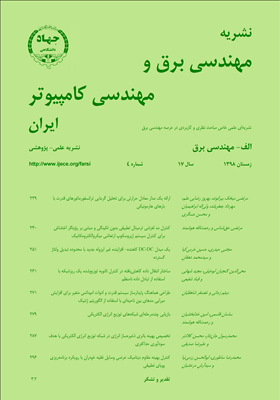تخصیص بهینه باتری ذخیرهساز انرژی در شبکه توزیع انرژی الکتریکی با هدف سودآوری حداکثری
محورهای موضوعی : مهندسی برق و کامپیوتر
محمد رسول جان نثار
1
,
محسن کلانتر
2
,
علیرضا صدیقی انارکی
3
![]()
1 - دانشگاه یزد
2 - دانشگاه علم و صنعت ایران
3 - مهندسی برق
کلید واژه: الگوریتمهای ابتکاریباتری ذخیرهساز انرژیتجارت انرژیسودآوری حداکثریکاهش اوج بار,
چکیده مقاله :
در این مقاله، تخصیص بهینه باتری ذخیرهساز انرژی در شبکه توزیع با هدف کاهش اوج بار و سودآوری حداکثری انجام شده است. برای این منظور، شاخصهایی با استفاده از اطلاعات بار ساعتی، هزینه ارتقای فیدر و قیمت فروش برق به تعرفههای مختلف، معرفی شده است. در ادامه با استفاده از روش تحلیل سلسلهمراتبی، شاخصها وزندهی شده و فیدر مناسب برای نصب ذخیرهساز مشخص شده است. سپس به منظور دستیابی به میزان حداکثر ممکن کاهش اوج بار و تأمین سود حداکثری، یک تابع هدف اقتصادی با هدف یافتن اندازه و نحوه شارژ و دشارژ بهینه ذخیرهساز تعریف شده است. تابع هدف شامل هزینههای نصب و بهرهبرداری ذخیرهساز، سود خرید و فروش انرژی، سود به تعویق افتادن توسعه شبکه، سود ناشی از مسایل زیستمحیطی و سود ناشی از کاهش هزینههای دسترسی به شبکه بالادست است. با توجه به کاهش اوج بار، محدوده توان و ظرفیت باتری و همچنین تعادل در میزان شارژ و دشارژ باتری، قیود مناسبی در نظر گرفته شده است. با توجه به غیر خطی بودن تابع هدف، در ابتدا مؤلفههایی که در غیر خطی شدن تابع هدف نقش داشتهاند با توجه به الگوریتمهای ابتکاری (ژنتیک، دسته ذرات، مورچگان و جستجوی ممنوع) تعیین شده و سپس تابع هدف توسط روش خطی نقطه داخلی حل شده است. نتایج ضمن تأمین اهداف مد نظر، مناسبترین باتری و روش بهینهسازی را از بین باتریها و روشهای معرفیشده ارائه میدهد.
In this paper, the optimal allocation of battery energy storage in the distribution network is performed for peak shaving and maximizing profitability. To this end, indicator shave been introduced using hourly load information, feeder upgrade cost and electricity sales price to various tariffs. Then, using the Analytic Hierarchy Process (AHP), the indicators are weighted and a suitable feeder is indicated for installing energy storage. Then, to achieve the maximum possible peak shaving and maximize profit, an economic objective function is defined to determine the optimal sizing and charge-discharge of the energy storage. The objective function includes the investment and operating cost of battery energy storage and the profits of energy arbitrage, deferring facility investment, environmental issues, and reducing the upstream access cost. Appropriate constraints are considered according to the peak shaving, range of battery power and energy capacity as well as balance in the amount of charge and discharge. Due to the nonlinearity of the objective function, the components involved in the nonlinearity of the objective function are determined according to the heuristic algorithms (Genetic Algorithm (GA), Particle Swarm Optimization (PSO), Ant Colony Optimization (ACO), and Tabu Search (TS)) and then the objective function is solved by the Interior-point linear programming. The results provide the most suitable battery type and optimization method among the introduced batteries and methods while fulfilling the objectives.
